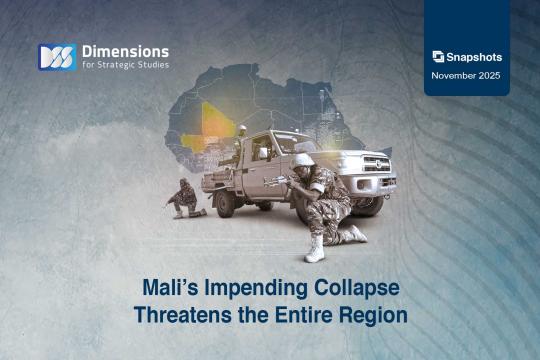
Sinwar’s Rise Brings Hamas Decision-Making Back to Gaza
2024-08-195294 view
In the aftermath of Israel’s assassination of Hamas political chief Ismael Haniyeh on July 31, the Palestinian movement swiftly selected Gaza strongman Yahya al-Sinwar to lead its political wing. This effectively placed him at the helm of Hamas as a whole, and placed the final say on its policy in the hands of Gaza-based officials.
This article examines the rise of Sinwar and the implications of his appointment, both for the current conflict in Gaza and the direction of Hamas as a whole.
The Rise of Sinwar
Sinwar, who was released in a prisoner swap with Israel in 2011, quickly rose through the Hamas, and by 2017 became head of its Gaza branch, one of the movement’s three offices (the others being in the occupied West Bank and overseas).
The president of the Gaza office draws influence from the fact that the office is in charge of the movement’s military apparatus, the Ezzedine Al-Qassam Brigades (or simply the Qassam Brigades). After all, it is the armed wing that gives Hamas its basic legitimacy, as an armed resistance movement against the Israeli occupation of the Palestinian territories. As such, the Qassam Brigades have a particularly large say in directing the movement’s trajectory and maintaining its legitimacy by pursuing its overarching goal: resisting Israel.
There are many examples of the Qassam Brigades’ views taking precedence over those of the political bureau—most notably in May 2021 and on October 7 last year, when the armed wing initiated fighting with Israel then tasked the political bureau with managing negotiations and conveying messages to mediators on the movement’s behalf.
When Sinwar was elected as head of the Gaza office in 2017 and again in 2021, his behavior showed that he had his sights on becoming head of the political bureau. He had a militant agenda, aimed at keeping Palestine and its surroundings in a constant state of combat, and avoiding appeasement with governments that would host Hamas offices in exchange for being able to dictate certain policies.
Since 2012 and his election as a member of the political bureau, Sinwar has been the direct and sole coordinator between the bureau and the military council of the Qassam Brigades. The latter consists of the Brigades’ commander, Mohammed al-Deif, Deif’s deputy Marwan Issa, and the head of the operations staff, Mohammed al-Sinwar (Yahya’s brother).
No decision is made on the military council without the approval of all its members, which means that Sinwar has substantial sway over the body’s decisions. Moreover, he has a tight grip over the Qassam Brigades’ lower military council, which includes the commanders of five brigades as well as the chiefs of specializations, arms manufacturing, the home front, organization and administration, all subordinate to the main council.
Since the start of Israel’s war on Gaza, while some members have been assassinated, most if not all of the survivors are loyal to Yahya Sinwar, a situation he engineered by launching investigations and removing many commanders during an evaluation of the Qassam Brigades’ performance during the 2014 war. He has also imposed financial, political, security and military influence over the government apparatus in Gaza since 2017.
Sinwar has thus established himself as head of the movement, pushing the Shura Council to choose him by canceling the installation of a competitor, Mohammed Ismail Darwish, and bypassing the movement’s diaspora head Khaled Meshaal, who was seen as a possible chief head of the political office on account of residing outside Gaza.
Sinwar’s appointment therefore shifts the movement’s entire center of gravity inside Gaza. Whereas Ismail Haniyeh had played the role of lynchpin, liaising between the Gaza office and those in the West Bank and abroad and taking the views of all three into consideration, today, the entire movement is subordinate to the decisions of the Gaza branch.
It is possible that Sinwar’s aim in taking control of Hamas was to oversee negotiations with Israel. He could thus ensure they proceeded according to developments on the ground, demand that negotiations be conducted directly and exclusively with Hamas within Gaza, and show Israel that the assassination of Haniyeh would not change the course of negotiations.
Sinwar is also seeking to establish that no solution in Gaza can be reached without the approval of Hamas, whose ultimate decisions are now taken inside the Strip, and which will fight until its last breath in order to maintain its presence in the Palestinian struggle.
Sinwar also believes that Hamas fighters constitute “the last fortress in the land of Palestine,” and that the fate of both the movement and the Palestinian cause are in their hands.
Sinwar’s Strategic Outlook
Hamas is likely to increase its demands in truce negotiations, insisting on a permanent ceasefire and a full Israeli withdrawal from Gaza. Israel, for its part, is clear that it intends to partially occupy Gaza, particularly the “Netzarim Corridor” bisecting the Strip and the “Philadelphi Corridor” along the border with Egypt.
Yet some flexibility on Sinwar’s part cannot be ruled out. He has shown a degree of pragmatism in the past, for example through his reconciliation with the movement led by former leading Fatah official Mohammed Dahlan. However, this pragmatism may only emerge after a certain period, in talks that are already faltering.
When it comes to international relations, since 2014—that is, before Sinwar took over the leadership of the Gaza office and the Qassam Brigades—the movement has sought to establish a strategic alliance with the Iranian-led “axis of resistance.” Sinwar has continued with this policy since assuming leadership of the Hamas political bureau in Gaza, sometimes in contrast with the vision of Hamas abroad and in the West Bank. He has adhered to the idea of reconciliation with the Syrian regime, and sent his deputy, Khalil al-Hayya, to represent Hamas in a delegation of Palestinian factions that visited President Bashar al-Assad.
With Sinwar now in charge of Hamas as a whole, the movement will likely build closer relations with this axis. It is also likely to maintain its relations with Türkiye, Qatar and other countries, but only as much as this serves its main goal: resistance to Israel.
Since taking the helm of the movement’s political bureau, Sinwar has had an opportunity to implement what he has long demanded: giving Gaza personnel greater representation on the movement’s Shura Council and a larger share of the its budget, given the weight Gaza represents compared to Hamas branches in the West Bank and the diaspora. This is especially true in light of Sinwar and his allies’ belief that Hamas members outside Gaza have not done enough to ease the burden on Palestinians inside the territory before and during the recent war. Moreover, the new Hamas chief is likely to be firm in getting what he wants, and will not accept anything that goes against his vision.
In summary, many of Sinwar’s wish-list for Hamas policy had already taken place before he took over as head of the political bureau. Now the Gaza command’s demands will take precedence by default, marginalizing or even totally ignoring the views of both the West Bank and Diaspora offices. Meanwhile, the group will continue to clash with Israel and likely step up armed activity in the surrounding countries, leading to a new approach in the group’s foreign relations, focused on gaining the maximum possible support against Israel.





